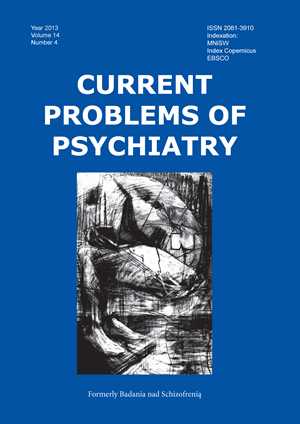Symptoms of anxiety and depression in patients with relapsing-remitting multiple sclerosis
Abstract
Aim. The aim of this article was to present the emotional functioning of patients facing the diagnosis of the chronic disease Multiple Sclerosis.
Methods. The instruments used in the study included a socio-demographic questionnaire, Cattell's Self-Analysis Form and the Beck Depression Inventory.
Participants. The study included a group of 108 patients with relapsing-remitting MS and 69 healthy controls (31 women and 38 men). The patients' disability score on Kurtzke's EDSS scale was 2.13 points. (2.0 points in the female group and 2.2 points in the male group). In the study period, all patients were in remission of MS symptoms.
Results and Conclusions. The analyses revealed that there were statistically significant differences between MS patients and healthy controls regarding the symptoms of anxiety and depression. Compared to healthy subjects, MS patients significantly more often experienced symptoms of depression in the sphere of emotions, somatic reactions and social relations. MS patients were characterized by significantly higher levels of overt, covert and general anxiety and higher levels of needs and drives, self-dissatisfaction, suspicious-ness, guilt and neurotic behavior than healthy controls. There were no significant differences in depressive symptoms between female and male patients. Men with MS, compared to female patients, were significantly more prone to neurotic behavior, self-blame and suspiciousness, and had more intense needs and drives and higher levels of overt and general anxiety.
References
1. Kubacka-Jasiecka D. Agresja i autodestrukcja z perspektywy obronno-adaptacyjnych dążeń Ja. Kraków: Wydawnictwo Uniwersytetu Jagiellońskiego, 2006.
2. Janssens A.C., van Doorn P.A., de Boer J.B. Anxiety and depression influence the relation between disability status and quality of life in multiple sclerosis. Mult Scler 2003; 9: 397-403.
3. Juszczak D., Talarowska M., Kowalewski M., Filewski A. Charakterystyka zaburzeń lękowych – występowanie w stawardnieniu rozsianym, możliwości leczenia oraz wpływ na proces rehabilitacji. Pol Merk Lek 2009; 27; 162: 532-534.
4. Mohr D.C, Cox D. Multiple Sclerosis: Empirical Literature for the Clinical Health Psychologist. J Clin Psych 2001; 57; 4: 479-499.
5. Chwastniak L., Ehde D. M. Gibbons L. E., Sullivan M., Bowen J. D., Kraft G. H. Depressive Symptoms and Severity of Illness in Multiple Sclerosis: Epidemiologic Study of a Large Community Sample. Am J Psychiatry 2002; 159: 1862-1868.
6. Parnowski T. Depresja w stwardnieniu rozsianym – punkt widzenia psychiatry. W: Psychologiczne aspekty stwardnienia rozsianego (red.) Potemkowski A. Poznań: Wydawnictwo Medyczne Termedia, 2010.
7. Jaeschke R i inni, 2010 Jaeschke R., Siwek M., Grabski B., Dudek D. Współwystępowanie zaburzeń depresyjnych i lękowych. Psychiatria 2010: tom 7; nr 5: 189-197.
8. Korostil M., Feinstein A. Anxiety disorders and their clinical correlates in multiple sclerosis patients. Mult Scler; 2007; 13: 67-72.
9. Garfield A. C., Lincoln N. B. Factors affecting anxiety in multiple sclerosis. Disabil Rehabil 2012; 34; 24: 2047-2052.
10. Brown R.F., Valpiani E.M., Tenant C.C., Dunn S.M., Sharock M., Hodgkinson S., Pollard J.D Longitudinal assessment of anxiety, depression and fatigue in people with multiple sclerosis. Psychol Psychother-T 2009; 82: 41-56.
11. Feinstein A., O'Connor P., Gray T., Feinstein K. The effect of anxiety on psychitric morbidity in patients with multiple sclerosis. Mult Scler; 1999; 5: 323-326.
12. Tsivgoulis G., Triantafyllou N., Papageorgiou C., Evangelopoulos M. E., Karrarizou E., Sfagos C., Vassilopoulos D. Associtions of the Expanded Disability Status Scale with anxiety and depression in multiple sclerosis outpatients. Acta Neurol Scand 2007; 115: 67-72.
13. Gay M-C. i inni, 2010] Gay M-C., Vrignaud P., Garitte C., Meunier C. Predictors of depression in multiple sclerosis patients. Acta Neurol Scand 2010; 121: 161-170.
14. Płużek Z. Podręcznik interpretacji Kwestionariusza Niepokoju Cattela. Skrypt KUL, 1968.
15. Beck A.T., Ward C. H., Mendelson M. An Inventory for measuring depression. Arch. Gen. Psychiatry 1961; 4: 53-63.
16. Martins da Silva A., Vilhena E., Lopes A., Santos E., Goncalves M. A., Pinto C., Moreira I., Mendonca D., Cavaco S. Depression and anxiety in a Portuguese MS population: Associations with physical disability and severity of disease. J Neurol Sci 2011; 306: 66-70.
17. Beal C. C., Stuifbergen A. K., Brown A. Depression in Multiple Sclerosis: A Longituidinal Analysis. Archiv Psych Nurs 2007; 21; 4: 181-191.
18. Beiske A. G., Svensson E., Sandanger I., Czujko B., Pedersen E. D., Aarseth J. H., Myhr K. M. Depression and anxiety amongst multiple sclerosis patients. Europ J Neurol 2008; 15: 239-245.
19. Leonavicius R., Adomaitiene V. Impact of depression on multiple sclerosis patients life activities and treatment quality. Biol Psych Psychopharmacology 2012; 14; 1: 8-12.


